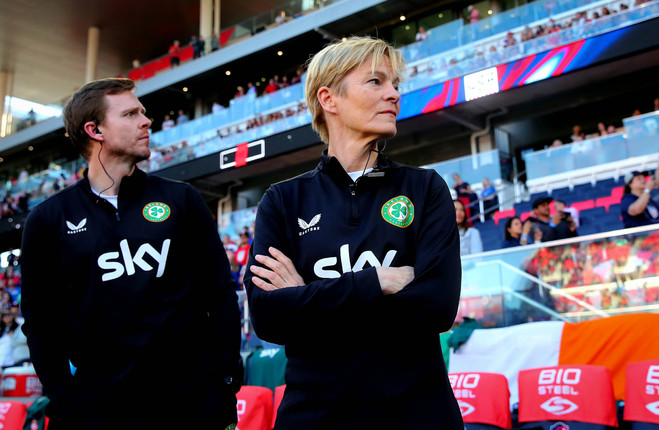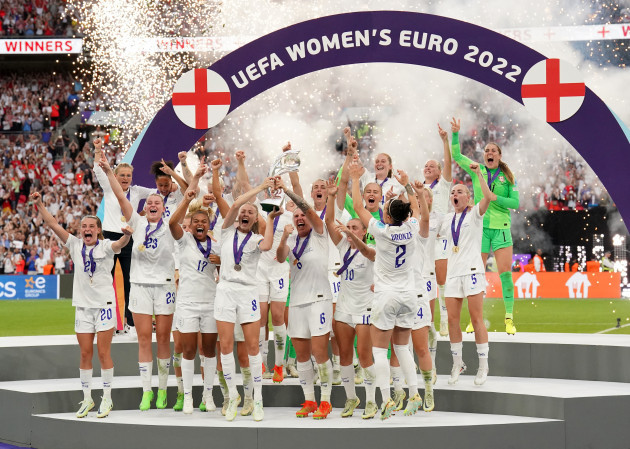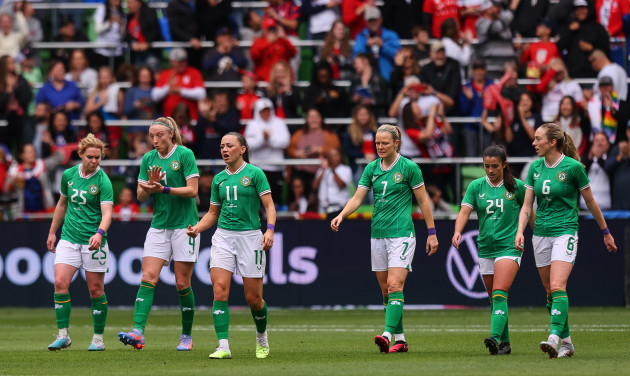WHILE THE FULL focus is on this summer’s World Cup, the Republic of Ireland will learn their Uefa Women’s Nations League fate on Tuesday morning.
The draw for the inaugural competition takes place at 12pm Irish time in Nyon [live on Uefa.com], with Vera Pauw’s side in Pot 1 of League B. They’re the top-seeded team in their league.
The Nations League will kick off in September — the men’s edition has been running since 2018 — and brings with it a new system for qualifying for the Women’s Euros, World Cup and Olympics. Six games will be played before the end of the year.
Pauw is not a fan, sharing her fears last August that this will be “detrimental” to the development of the women’s game — and could result in in being “virtually impossible” for Ireland to qualify for major tournaments going forward, like Euro 2027 in Switzerland.
The Ireland boss finds issue with Uefa’s favouritism towards League A teams.
“The key thing is that the [2022] Euros was a reflection of the money,” Pauw explained last summer. “It’s a pity that in our game the big money goes to the top, the second tier is forgotten and the third tier gets support to develop into the second level.
“They have invested a lot in the top, then the issue is that the association [Uefa] needs to take care of the second tier. The ones with money get more money, the ones with average get nothing, the ones with no money get support. That’s the situation at the moment.
“The plans are, the first tier will have the top 16 countries based on Uefa’s coefficient points, not including friendly games. It would bring Ireland into the second tier. Then the group winner from the second tier, after playing two years on the lower level, need to play the second team from the top tier. That is without the opportunity of playing friendly games.
“It means the chance of qualifying will be minimised instead of being open to the second tier. The top teams will go away from the rest and stop the game’s development.”
With Pauw’s fears realised, let’s try to explain the Women’s Nations League in the most straightforward way possible.
What do I need to know ahead of the draw?
The teams in each league have been decided — according to the latest Uefa coefficient rankings — and have been assigned into four pots based on their seedings.
Leagues A and B will feature four groups of four teams (one drawn from each pot) while League C will be made up of four groups of four teams and one group of three (one drawn from each pot for the groups of four teams; one from each of the first three for the other group).
Here’s a look at how things stand before the draw:
League A
Pot 1: England, Germany, France, Sweden
Pot 2: Spain, Netherlands, Norway, Denmark
Pot 3: Italy, Belgium, Austria, Iceland
Pot 4: Switzerland, Wales, Portugal, Scotland
Due to winter venue restrictions, a maximum of two of Sweden, Norway and Iceland may be drawn in the same group.
League B
Pot 1: Republic of Ireland, Poland, Czech Republic, Finland
Pot 2: Serbia, Slovenia, Northern Ireland, Romania
Pot 3: Ukraine, Bosnia and Herzegovina, Slovakia, Hungary
Pot 4: Greece, Croatia, Belarus, Albania
Ukraine and Belarus cannot be drawn in the same group.
League C
Pot 1: Malta, Israel, Azerbaijan, Turkey, North Macedonia
Pot 2: Kosovo, Montenegro, Luxembourg, Estonia, Moldova
Pot 3: Lithuania, Kazakhstan, Latvia, Bulgaria, Cyprus
Pot 4: Faroe Islands, Georgia, Armenia, Andorra
A maximum of two of Estonia, Latvia, Lithuania and Faroe Islands may be drawn in the same group, also due to winter venue restrictions. Kazakhstan can be drawn in a group with only one of Andorra, Faroe Islands and Malta due to travel burden. Azerbaijan and Armenia cannot be drawn in the same group.
And then?
The teams in each group will play on a home and away basis in a league system. Three points are awarded for a win, one for a draw and none for a defeat.
The 2023-24 competition will get underway in September, with the first two rounds of games taking place that month. There will be four more matchdays: two in October, one across the end of November and beginning of December, and one more a few days later.
The final standings will determine promotion and relegation between tiers and finals.
The four group winners in League A will contest the Women’s Nations League finals. There will be two single-leg semi-finals, a third-place match and a final.
The group winners in Leagues B and C will be promoted. The teams who finish bottom of the groups in Leagues A and B will be relegated, as will the lowest-ranked third-placed team in League B.
Promotion and relegation matches will also be played between the third-place finishers in each group in League A and second-placed teams in each group in League B. These will be two-legged ties, with the winners to earn a place in League A.
Minus the automatically-relegated third-place League B team, the third-placed teams in League B will also face the three best second-place teams in League C for spots in League B.
Still with us?
One more thing, for now:
How does the Nations League impact Euros, World Cup and Olympic qualifying?
After all of those games are complete, the promotions and relegations will be reflected in the leagues for the European qualifying stage. So how teams fare in the Nations League will have a direct impact on their Euros fate, first off — coefficients, seedings, all of that.
Those qualifiers begin in Spring 2024.
Uefa’s new qualification system will also be in place for the 2027 World Cup.
Meanwhile, the top two eligible teams in the 2023-24 Nations League finals will qualify for the 2024 Olympics. This excludes France, who qualify automatically as hosts.
Ireland’s focus, however, will remain on the World Cup, Euros and now, of course, the inaugural Nations League.
Read more, from the FAI, here.



